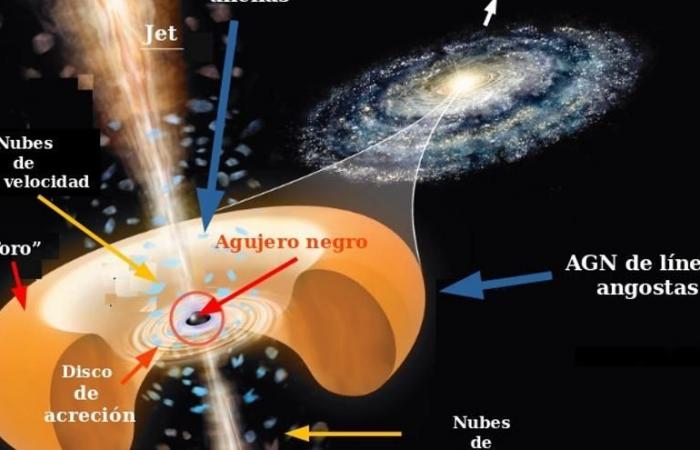Astrophysicists from several countries around the world have achieved, thanks to James Webb Space Telescope “look out” at one of the most massive and distant black holes from Earth, located about 13,000 million light years and when the Universe was “only” about 800 million years old.
The results of the research workin which several astrophysicists from the Astrobiology Center (CAB) – dependent on the Higher Council for Scientific Research (CSIC) and the National Institute of Aerospace Technology (INTA) – have had an important role, are published this Monday in the journal Nature Astronomy.
And the most “surprising” thing for researchers, the CAB reported in a note released this Monday, was verifying that this distant and massive black hole is “fed” in the same way as the most recent and closest black holes in the Universe. .
Astrophysicists have been trying to explain for years how black holes wonin the earliest times of the Universe, its extraordinary massand the new results obtained from observations by the James Webb Space Telescope now rule out the existence of “exotic” mechanisms that had been proposed as a possible solution to these questions.
The “cosmic dawn”
Because the first 1 billion years of cosmic history – the so-called “cosmic dawn“- pose a challenge for science, to reveal how the first black holes became so massive and in such an accelerated manner, since those known in the centers of galaxies have surprisingly large masses.
Stars and galaxies have changed enormously since, and over the last 13.8 billion years, the life span of the Universegalaxies have grown and gained more mass, either because they have consumed the surrounding gas or, occasionally, because they have merged with each other.
That is why astronomers had been surprised when, during the last twenty years, observations of quasars (very luminous and distant galaxies in the Solar System) had revealed some very young black holes that had nevertheless reached enormous masses, up to 10 billion solar masses.
The CAB has explained that light needs time to travel from a distant objectso “looking” at distant objects means looking into the distant past and seeing the most distant known quasars as they were during the “cosmic dawn,” which is about a billion years after the Big Bang, when the stars formed. first stars and galaxies.
Spanish science and technology
There are many explanations that Researchers have gone so far to try to explain how the first black holes became. so massive so quickly, although no scientific reasoning is completely accepted, but the instruments that the James Webb incorporates, including the MIRI medium infrared instrument, have made it possible to take “a gigantic leap” in these studies.
That instrument was built by a international consortium with the participation of scientists and engineers from the Higher Council for Scientific Research (CSIC) and the National Institute of Aerospace Technology (INTA), and in exchange for building it the consortium received a certain amount of observation time.
In 2019, years before the launch of the James Webb Space Telescope – an international collaboration between ESA, NASA and the Canadian Space Agency – that international consortium had already decided to use part of this time to observe what was then the most distant quasar known. , an object bearing the designation “J1120+0641”.






